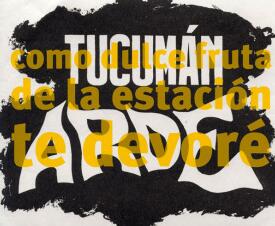Roberto Jacoby at the Reina Sofía Museum, Madrid
El deseo viene del colapso (Desire Comes from Collapse)
Roberto Jacoby’s (Buenos Aires, 1944) work is characterized by a constant transit from the borderlines of artistic production. Since his first years as an artist tied to the famous Instituto Di Tella, which led to the mythical and revolutionary Tucumán Arde (1968), his work is conceived as a continuous amplification of the notion of artistic work. Amongst other things, he has been the lyricist of the famous rock/glam group Virus, he has done work in sociology and political theory, he has been a theatre critic, and a journalist for clandestine journals. His versatility has complicated the systematic exhibition of his work, which this exhibition seeks to end.

With the intention of portraying this in-disciplinary character, the exposition has been distributed in different spaces that represent fragments of some of the faces, moments, and modes of production of Jacoby’s work. Espacio Uno is divided into two parts: Vivir aquí (To live here), a reconstruction realized in collaboration with another three artists (Marina Caro, Mariela Scafati, and Daniel Joglar) of the inserted action in the Semana de Happening from 1965. It is consistent in the transfer of elements from his home/workshop to the gallery; *1968 el culo te abrocho* (2008) (I buckle your ass) contains impressions of Marx’s bust intervened, and a musical ambience of the Vines, showing diverse models of politicization that range from the interpretation to corporal insubordination.
The vault room contains Darkroom (2005), a series of video records of the homonymous performance developed by a single spectator in complete darkness, only made visible with the use of a nocturnal camera. La castidad (Chastity) (2006-2007) is a complex video that reconstructs in the fictiomental style the contract of the convivencia casta (chaste coexistence) that he maintained for a year with the artist Syd Krochmalny. The Protocol Room contains Gabinete de curiosidades (curiosities cabinet), composed by a diverse paraphernalia from his actions, that consciously reproduces the conditions of distancing, sacrilege, and fetishism of the exhibited document. A digital document of his work is also available upon request.
Jacoby’s work, as a whole, poses a complex environment in which accepted norms dissolve and generate spaces in which the link to the social is inevitable. This constant fluctuation between the individual and the collective has led to a generation of networks inside and outside the realm of art. Evidence of this are the different projects that have been realized from the ‘90s until now, in which the collaboration and the creation of networks is fundamental; such as Chacra (1999), Proyecto Venus (Project Venus) (2000-2006) and the fundamental Argentine contemporary art magazine ramona (2000-2010). The controversy that surrounded his participation in the in Sao Paulo Biennial in 2010, an unofficial election campaign office organized by various Argentine artists that supported one of the candidates in the Brazilian elections, testifies to the vitality and the actuality of his work.
*Dates:* February 25th- May 30th, 2011
*Location:* Sabatini Building, Espacio Uno, Sala Bóvedas y Sala de Protocolo
*Related Videos: *
Ricardo Piglia, about Roberto
Jacoby<http://www.museoreinasofia.es/archivo/videos/piglia.html>
Roberto Jacoby and Ana
Longoni<http://www.museoreinasofia.es/archivo/videos/jacoby.html>
Related Publications:
Ana Longoni (ed.). Desire comes from collapse. Roberto Jacoby. Actions,
concepts, writings<http://www.museoreinasofia.es/publicaciones/catalogo.html?idPub=417>,
Museo Reina Sofía, 2010.






